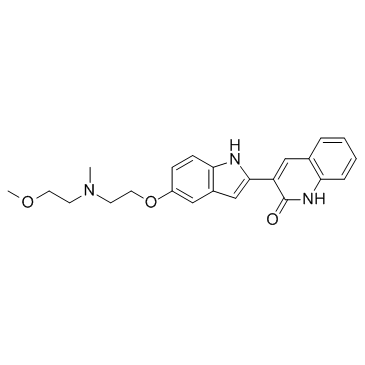| Description |
KDR-in-4 is a potent kinase insert domain-containing receptor (KDR/VEGFR2) inhibitor with an IC50 of 7 nM.
|
| Related Catalog |
|
| Target |
KDR:7 nM (IC50)
|
| In Vitro |
KDR (kinase insert domain-containing receptor) is one of the human tyrosine kinases that has a high affinity for vascular endothelial growth factor (VEGF) and is believed to be a primary mediator of tumor-induced angiogenesis[1].
|
| In Vivo |
KDR-in-4 may prove to be useful for the treatment of a variety of ocular neovascular diseases using a convenient oral dosing regimen. At doses of 100 mg/kg, KDR-in-4 results in a 98% reduction in lesion size in the rat choroidal neovascularization (CNV) model. 30 mg/kg doses of KDR-in-4 shows a 70% and 80% reduction in lesion size in the laser CNV and rat oxygen induced retinopathy (OIR) models, respectively[2].
|
| Animal Admin |
Rats: KDR-in-4 is dosed by oral gavage for 12 days at 0, 10, 30, or 100 mg/kg in an adult male Brown Norway rat laser induced choroidal neovascularization (CNV) model. The areas of CNV lesions are quantitated by fluorescence image analysis of FITC-dextran perfused animals. KDR-in-4 is also assessed in a rat oxygen induced retinopathy (OIR) model in which neonatal rats are placed in an oxygen chamber that delivered alternating 24 h cycles of 50% and 10% oxygen for 14 days. After 14 days of oxygen treatment, the animals are returned to room air and dosed orally for 7 days with 0, 10, or 30 mg/kg kinase inhibitor. The extent of retinal neovascularization is assessed by counting pre-retinal neovascular nuclei on histological sections[2].
|
| References |
[1]. Fang YQ, et al. Efficient syntheses of KDR kinase inhibitors using a Pd-catalyzed tandem C-N/Suzuki coupling as the key step. J Org Chem. 2007 Feb 16;72(4):1341-6. [2]. Kinose F, et al. Inhibition of retinal and choroidal neovascularization by a novel KDR kinase inhibitor. Molecular Vision 2005; 11:366-373
|
